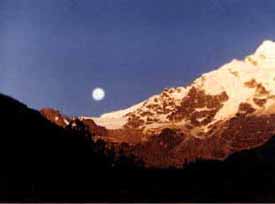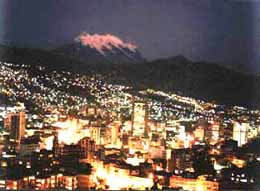|
MAMA INDIA
- Los Yuras - Bolivia
My group Achalay used to do a nice version of this song, which is
a prayer to Mama India (Pachamama, the Earth Goddess) to send rain to
the parched earth.
CHAYA de la
SOLEDAD - Quinteto Tiempo -
Argentina (EMI 62916755)
The
chaya is a song/dance style from the Province of La
Rioja in Argentina.
VILLANCICO
TRADICIONAL de SUCRE - Jaime Torres - Bolivia
The villancico is a Christmas song. Sucre is the political
capital of Bolivia
SELECCIÓN de
ZAMBAS - Chito Zeballos -
Argentina (Polydor 10070)
This singer had the brilliant idea of putting together four
zambas,
the national dance of Argentina, linking them with recitations. They
are (a) Serenata Riojana (b) Tacita de Plata (c) Bombo Legüero and
(d) Canta Zamba.
ALLÁ VIENE el
CORAZON -
Soledad
Bravo - Venezuela
(Buda
B000001N7S)
DOLENCIAS
- Inti-Illimani
Ecuador
PAJARILLO VERDE
-
Soledad
Bravo -
Venezuela
(Buda
B000001N7S)
LONGUITA
-
Inti-Illimani
Ecuador
MI PARTIDA
- Las Bellas de Abancay - Peru
Very nice Peruvian huayno sung by a trio who call
themselves "The Beauties of Abancay". Abancay, here I come……………
RETAMITA VERDE/HUAYLLASH
- Inkuyo - Ecuador
Two songs from Ecuador with some beautiful harp’playing.
BAILECITO
-
Anastasio Quiroga - Argentina
(Disc Jockey LD 15136)
Field recording made in the Quebrada de Humahuaca, Province of
Jujuy in northern Argentina.
BAILE
ECUATOREANO - Facio Santillán -
Ecuador (MF-137)
A quena solo with accompaniment.
SI
ME QUIRES VER MORIR - An. y Lucinda Quiroga -
Argentina
(Disc Jockey LD
15136)
A cueca recorded in Jujuy, northern Argentina, accompanied
on charango
PALOMA
- Savia
Nueva Bolivia
LA
BANDEÑITA - Facio Santillán -
Argentina
This is an instrumental
chacarera, a dance from Santiago del
Estero in Argentina, played as a solo for quena.
SANJUANITO
de MEDIANOCHE - Inkuyo -
Ecuador
The sanjuanito is a lovely folkdance from Ecuador.
ACO
ÑANEYNAMBUMÍ
- Los Indios -
Paraguay (Philips TFE 17261)
A
polca paraguaya sung in the beautiful Guaraní language
of the indians of Paraguay.
MI
RAZA - Los Yuras - Bolivia
An aymara song beautifully arranged and played with the panpipes
much in evidence. These are known in the Andes, both as sikus
and zampoñas. Each set of pipes has half the scale, so two
players are needed, each contributing the notes he has at the right
instant (rather like the old English art of bell-ringing). Nowadays it
is common for one player to play both sets of pipes, holding one set
behind the other.
JURO
AMARTE - Jaime Torres -
Bolivia (Philips 85526 PY)
A bailecito beautifully played and sung by a group led by
the great Argentine/Bolivian player of the charango, Jaime
Torres. The title means "I Promise To Love You".
ARBOLITO
de DURAZNO - Machu Picchu - Bolivia
(TUMI CD 011)
A Bolivian bailecito called "The Plum Tree".
LA HUMILDE/CHACARERA
del CAMPO - Adolfo Ábalos -
Argentina
(Kerdum
3004 096)
Two Argentine chacareras "The Humble Woman" and
"Country Chacarera" played on piano by Señor Ábolos, who
seems to be starting a new career as soloist after a lifetim playing
in the group Los Ábolos with his four brothers.
ADIÓS PUEBLO
de AYACUCHO - Inkhay - Peru
(LAT 50615)
There are many recordings of this Peruvian song, mostly by
soloists on harp or guitar. It's a nice change to hear it played here
on two quenas.
ANTONIO RETOÑO
- Paul Farren
I've inserted this bit of nonsense by me. I found the words (no music)
in a book and they were so outrageous, I felt moved to make up a tune
in a style vaguely of the north coast of South America. If you are
even slightly "womens lib" you won't want to read this:
"Antonio Retoño mató a su mujer
Con un cuchillito tan grande como él.
Le sacó las tripas, las puso a vender
Y con lo que hizo, compró otra mujer
.
Antonio Retoño mató a su mujer
Con un cuchillito tan grande como él.
Hizo empanadas y salió a vender
¡Fueron muy sabrosas, siendo de mujer!
¡Hay que tener cuidado con todo de comer!"
"Antonio Retoño killed his woman
With a knife as big as himself.
He cut out her tripes and sold them as meat
And with what he made he bought another woman.
Antonio Retoño killed his woman
With a knife as big as himself.
He made her into meat pies and went out to sell them
They were very tasty, being made of woman!
You{ve got to be so careful with food!"
CORAZÓN-CORAZÓN
- Altiplano - Ecuador (EUCD
1416)
Beautiful arrangement of this old Ecuadorean song.
YERBA SILVESTRE -
Martina Portocarrero - Peru
This lady comes from Peru and insists on weraing the costume
appropriate to whichever region her song comes from. In between
songs she changes hats, shawls, etc. Her accompanists play the full
range of Peruvian instruments.
SAN MIGUEL de MORROPÓN
- Alpamayo - Peru (EUCD 1220)
This is a tondero from Peru – a rhythmic style which
features repeated rising musical phrases.
INTIPAPA - Inkuyo - Ecuador
A lovely song from Ecuador with the rondador given
plenty to do.
CULILY CAMPASILLITA
- Los Laris - Bolivia
This is one of the up-and-coming young Bolivian groups
SIMIRUCO -
Alpamayo - Ecuador (EUCD 1220)
This is one of those songs which every Ecuadorean group has in
its repertoire. The dance style is called capishca. The
Quechua spoken in Ecuador has many such "sh" sounds in it.
DESDE AQUELLA MAÑANITA
- Los Embajadores - Ecuador
(ALP 1291)
The pasillo is the Ecuadorean equivalent of the Peruvian
Waltz. I had liked this record for a long time before I actually
went to Ecuador. One evening, having had dinner in the hotel, I was
walking down Amazonas and saw a sign outside a tavern "Trio
Ecuatorial Here Tonight". I had to hear them, so I went in, sat
at a table and was told that one ("one" being me) had to
order dinner. So I ordered a dinner I couldn't possibly eat and a
bottle of wine I didn't want, but I did hear Trio Ecuatorial...in
fact they came and sang a request for me at my table. At that time,
I didn't know the Spanish for "rip-off", but the music was
worth it!
LA ROSA y LA ESPINA -
Los Calchakis - Bolivia
Los Calchakis call this "The Rose and the Thorn", but
I've heard it many times under a different name, "Recuerdos de
Kalahuyo" The sleeve-notes of the album tell us that "...the
South American natives ingeniously used the abundant armadillo
shells of their country to build mandolines..." Actually, they
are even more ingenious and make a very tasty stew from the
armadillo, as well!
CERQUITA del CORAZÓN
- Dúo J-M Anguedos - Peru
Very Peruvian song accompanied on charango and guitar.
YARAVI
- Achalay -
Ecuador
This is my group. Our Colombian member was studying music at
London University and brought to a rehearsal a book in which he had
found an Ecuadorean theme - just one line of music containing the
basic tune, but we liked it and made this arrangement.
DOS ZAMBAS
- Los Hermanos
Ábalos -
Argentina (Camden CAS-227)
Earlier, I mentioned that Adolfo Ábolos used to play in a group
with his brothers. Well, concurrently, this group of 5 or 6
brothers was also making records, mostly of Argentine regional dances.
These two zambas are "Siete de Abril" (April 7th) and
"La Nana". The second one is a real old fashioned country zamba,
the sort of thing you'd hear at a Saturday night dacne in a
village in Tucumán or Jujuy. I recently attended an Argentine concert
and saw the zamba being danced. It was so beautiful and
graceful, it was heartbreaking. When you hear a record of a zamba
it
is intended to be danced to and the song must contain the right number
of bars of intro, first verse, second verse, middle eight and last
verse.
EL
HUASICAMA - Carlota Jaramillo y conjunto -
Ecuador
This woman is the heart and soul of Ecuadorean song.
LOS
RUEGOS
- Los Morochucos
- Peru
Parlophone (PMC 1217)
This excellent Peruvian group describe this as: triste con fuga de
tondero (sad song with fugue in the style of a tondero). You've
already heard a sample of tondero in the song San Miguel de
Morropón.
VIDALA
de la VIDA - Paul Farren
I love this instrument, the tiple, the national instrument
of Colombia. Its very special sound comes from the way it is strung:
it has 12 strings strung in four groups of three. Here comes the
clever bit: the top set of 3 are metal strings, but the other three
sets are arranged with one metal string sandwiched between two nylon
strings and the metal ones are always tuned an octave above the nylon
ones. I found the words (no music) in a book and decided they fitted
nicely into the rhythm of the Argentina vidala and this is the
result.
|

